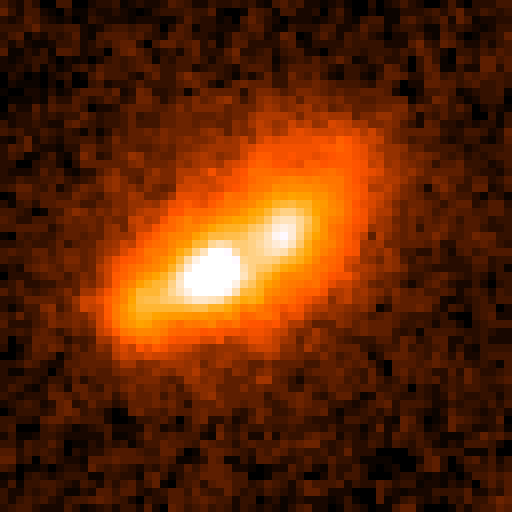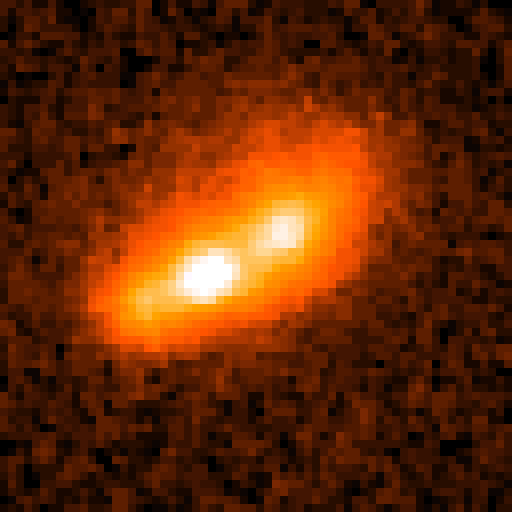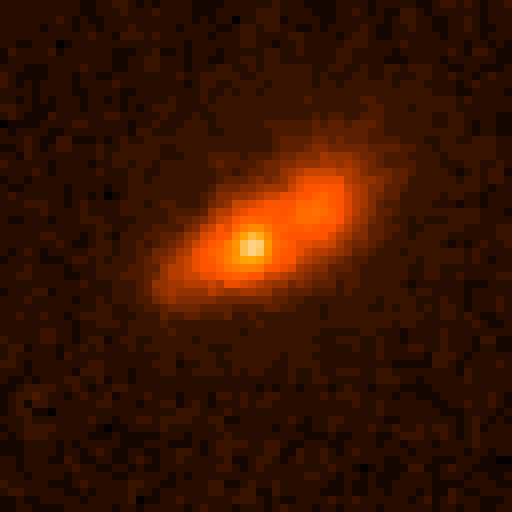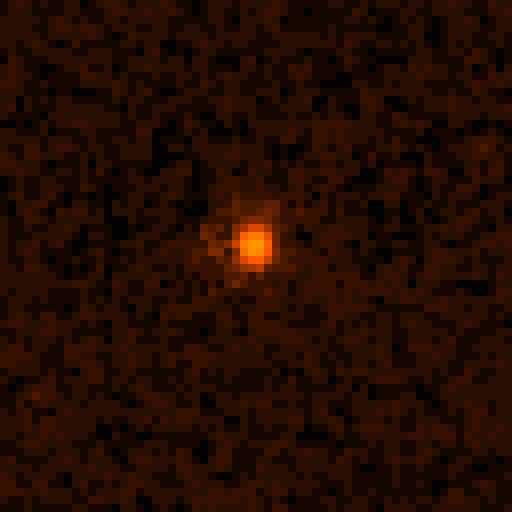On July 12, 1999 a GRB was detected by the BeppoSAX GRBM and WFC instruments.
- BeppoSAX GRB alert n. 99/19
On July 12, 16:43:02 UT a GRB (GRB990712) was detected
simultaneously by the GRBM and WFC of BeppoSAX.
Preliminary coordinates from WFC are:
R.A.(2000)= 337.830
DEC(2000)= -73.346
The current error radius is of about 5'
Due to Sun constraints BeppoSAX cannot perform a follow-on observation
with the NFIs.
- BeppoSAX GRB alert n. 92017
Refined coordinates of GRB990705 are :
R.A.(2000)= 337.9568
DEC(2000)= -73.4066
The error radius is now of 2'.
- GCN notice #385
On July 12, 16:43:02 UT a GRB (GRB990712) was detected
simultaneously by the GRBM and WFC of BeppoSAX.
The refined WFC position of GB990712 is:
R.A.(2000)=337.9568
DEC(2000)= -73.4066
The error radius is now of 2'.
Due to Sun constraints BeppoSAX cannot perform a follow-on observation
with the NFIs.
- GCN notice #387
Gaspar Bakos (STScI and Konkoly Observatory), Kailash Sahu (STScI) and
John Menzies (SAAO) observing on behalf of the PLANET collaboration, and
Paul Vreeswijk (Univ. Amsterdam) and Filippo Frontera (ITESE, CNR, Bologna)
on behalf of the Amsterdam/Beppo-SAX-Bologna GRB follow-up team report:
GRB 990712 WFC error circle (Frontera et al. GCN #385) was observed with the
1m telescope of the South African Astronomical Observatory at Sutherland
on July 12.87 UT in R filter with an integration time of 900 sec. Comparison
with the Digitized Sky Survey (DSS) image shows a relatively bright source
at RA (2000) = 22 31 53.1, Dec (2000) = -73d 24' 29" (with a positional
uncertainty of about 1 arcsec) which is absent in the DSS image. Based on
the red magnitudes of thee USNO stars in the field, the estimated magnitude
of the new source is R = 17.85 +/- 0.2. Since the limiting magnitude of the
DSS image is at least 21, the new source is most likely the optical counterpart
of GRB 990712. Further observations are urged. A finding chart of the
optical counterpart can be seen at
http://www.stsci.edu/~ksahu/grb990712 and is reproduced below.
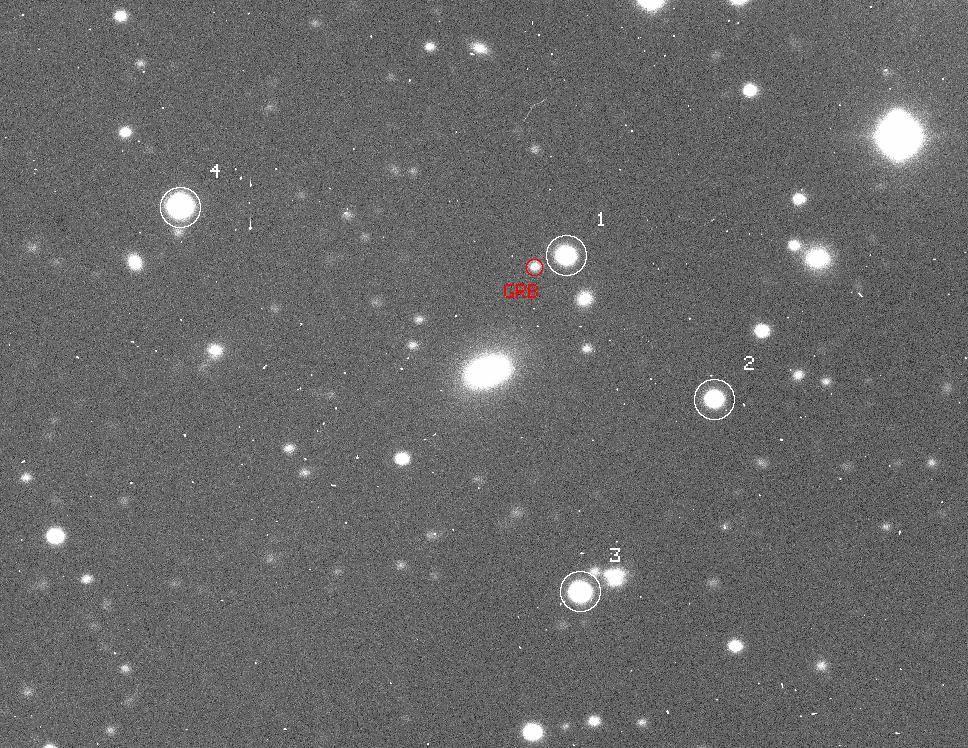
The image has a dimension of 5 x 4 arcmin. North is up and East is to the left.
- GCN notice #388
T.J. Galama, P.M. Vreeswijk, E. Rol, L. Kaper (U. of Amsterdam),
N. Masetti, E. Pian, E. Palazzi, F. Frontera (ITESRE, CNR, Bologna),
J. van Paradijs (U. of Amsterdam and U. of Alabama in Huntsville) and
C. Kouveliotou (USRA/MSFC) report on behalf of the
Amsterdam/Huntsville and BeppoSAX GRB optical follow-up teams:
Three 10-min low resolution spectra, covering 3500-8000 Angstrom, were
taken of the optical counterpart to GRB 990712 (Bakos et al., GCN
#387) with the European Southern Observatory (ESO) VLT-UT1 telescope,
starting July 13.17 UT 1999. We detect pronounced emission lines, as
well as some absorption features, that we identify as follows: MgII
(blend of 2796 and 2803) and MgI (2852) in absorption, [OII] (3727),
H-gamma (4340), H-beta (4861) and [OIII] (4959 and 5007) in emission.
From these lines we determine a preliminary redshift at 0.430 +/- 0.005.
- GCN notice #389
J. Hjorth (University of Copenhagen) and F. Courbin, J. Cuadra, D. Minniti
(Universidad Catolica de Chile) report:
We have obtained a 5-min R-band exposure of the optical afterglow of
GRB 990712 (Frontera, GCN #385; Bakos et al., GCN #387) with the
ESO 3.5-m NTT on 16.403 July 1999 UT. We detect an unresolved (seeing
FWHM = 1.8") object at RA (2000) = 22 31 53.03, Dec (2000) = -73 24 28.3
(with a positional uncertainty of +- 0.6" relative to the USNO-A2.0 system),
consistent with the position of the bright decaying source discovered by
Bakos et al. (IAUC 7225). We have tied our photometry to the PLANET
photometric zeropoint (K. Sahu, personal communication) and find that the
object has continued to fade to R = 21.48 +- 0.02 (systematic) +- 0.05
(random). The combined SAAO data (Bakos et al., IAUC 7225) and NTT data
indicate that the light curve is leveling off relative to a power law
decline. Assuming that the light curve can be modeled as the combined effects
of a power law decline of the OT and a constant contribution from the host
galaxy we find an OT decay slope of -0.81 (i.e. a rather slow decay) and a
bright host galaxy with R = 22.0. Such a bright host galaxy would be
consistent with its fairly low redshift (z = 0.43) and would possibly even
account for the prominent emission lines seen in the VLT spectrum
(Galama et al., GCN #388). We caution however that the hypothesis of a bright
host galaxy is based on just a few data points. To test this hypothesis
continued monitoring of the system is therefore urged. The NTT image and the
R-band light curve are posted at
http://www.astro.ku.dk/~jens/grb990712/ and reproduced below.
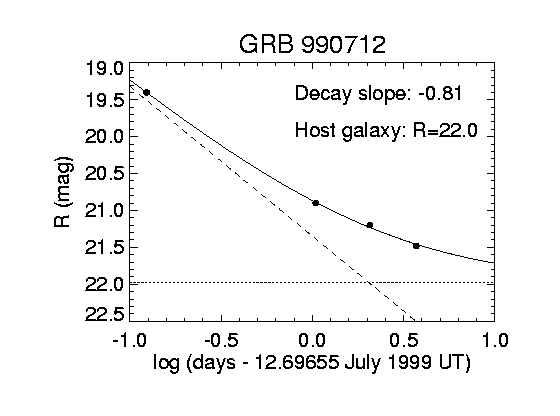
The R-band light curve of the optical afterglow of GRB 990712. The three first
points are from SAAO, the last point is based on the NTT image. Error bars
are about the size of the data points. The dotted line shows the contribution
from the purported host galaxy and the dashed curve is the assumed power law
decline of the optical afterglow emission. The solid curve is the combined
effect of these contributions and gives a good fit to the observations.
- GCN notice #391
I. Thompson, G. W. Preston (OCIW), J. S. Bloom, F. A. Harrison, S. R.
Kulkarni, S. G. Djorgovski (Caltech), D. A. Frail (NRAO) report on behalf
of the larger GRB collaboration:
On the night of 14 July 1999 UT we
imaged the field of GRB 990712 (IAUC #7221) with the 100-inch telescope at
Las Campanas, Chile. In a single 120-s V-band exposure we detect a faint
source coincident with the position of the optical transient discovered by
Bakos et al. (IAUC #7225). Based on the magnitudes of the 4 V-band
secondary standard stars provided by Bakos et al. (IAUC #7225), in a 3.9
arcsec radius aperture, we find V=21.88 +/- 0.24 mag (July 14.421 UT) of
the transient+host. This magnitude is consistent with the nearly-coeval
measurement reported by Bakos et al.
- GCN notice #402
J. Kemp & J. Halpern (Columbia U.) report on behalf of the
MDM Observatory GRB follow-up team's southern extension:
We observed the optical counterpart of GRB 990712 in the R band
on Aug. 16.32 UT using the CTIO 0.9m. A total of 50 minutes exposure
was obtained in seeing of 2."0. An object of R = 21.73 +/- 0.06 is
detected at position (J2000) RA 22:31:53.00, Dec -73:24:28.7 in the
USNO-A2.0 reference system, with uncertainty of 0".4. This is consistent
with the OT position as measured by Bakos et al. (GCN #387) and
Hjorth et al. (GCN #389). The magnitude is referenced to the secondary
standards used by Bakos et al. (IAUC #7225), although our own calibration
using Landolt standards (cf. GCN #395) is about 0.08 mag brighter.
The object appears only marginally extended in these images of relatively
poor seeing. Revising the decay model of Hjorth et al. (GCN #389), we
find a slope of -1.05 and a constant contribution of R = 21.78 from the
host galaxy. An extrapolation of the OT decay with a slope of -1.05 would
have predicted R = 25.5 at this time. In this model, the observed light is
now dominated by the host galaxy. HST observations are needed to follow
the afterglow decay, and to locate it within its relatively low-redshift
host galaxy (z=0.43, Galama et al. GCN #388). An HST observation is
scheduled for Aug. 29. If the OT decay continues with a slope of -1.05,
it will be found at R = 25.9 on Aug. 29.
The CTIO image and revised decay curve are posted at
http://www.astro.bio2.edu/grb/ and reproduced below:
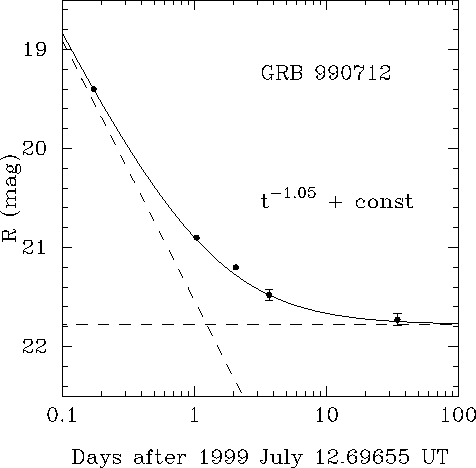
- GCN notice #403
J. Hjorth (University of Copenhagen), J. Fynbo (University of Aarhus and ESO),
A. Dar (Technion, Haifa and CERN), F. Courbin (Universidad Catolica de Chile)
and P. Moller (ESO) report:
We have obtained a 4-min R-band exposure of the optical afterglow + host
galaxy of GRB 990712 (Bakos et al., GCN #387; IAUC 7225; Hjorth et al.,
GCN #389; Kemp & Halpern GCN #402) with the ESO 8.2-m Antu telescope on
12.232 August 1999 UT. The OT + host has R = 21.71 +- 0.03 on the PLANET
photometric system and is slightly extended in seeing FWHM = 1.2" as revealed
by (i) faint but significant residuals after fitting and subtraction of a
point source (ii) deconvolution (Magain et al., ApJ, 494, 452, 1998). The host
galaxy is oriented roughly E-W. The decay slope of the optical transient
(-1.03) and host galaxy magnitude (R = 21.76) are consistent with the
prediction of Hjorth et al. (GCN #389) when correcting for the erroneous date
of the first data point of Bakos et al. (IAUC 7225) and with the findings of
Kemp & Halpern (GCN #402). The R band light curve can also be fit by a galaxy
(R = 21.92) and an OT with initial power-law decay (-1.00) that is taken over
later by a ``standard candle'' SN (Dar, astro-ph/9902017; Bloom et al.,
astro-ph/9905301; Dar, GCN #346; Reichart, astro-ph/9906079; Galama et al.,
astro-ph/9907264) like 1998bw (Galama et al., Nature, 395, 670, 1998;
McKenzie & Schaefer, astro-ph/9904397) at the redshift of the GRB (z = 0.43;
Galama et al., GCN #388). The HST observation of GRB 990712 scheduled for
August 29 can distinguish between the two models which predict OT magnitudes
of R = 25.80 in the simple power-law model and R = 24.20 in the power law + SN
model (or R(SN) = 24.58 if the power law decline steepened before August 29).
The takeover by a SN light curve would also result in a dramatic reddening of
the afterglow colours. Alternatively, the two models can be discriminated by
high-precision R band observations obtained around 1 August 1999 UT or by
late-time observations of the host galaxy brightness. The VLT image (before
and
after point source subtraction or deconvolution) and the R-band light curves
for the two models are posted at
http://www.astro.ku.dk/~jens/grb990712/ and reproduced below.
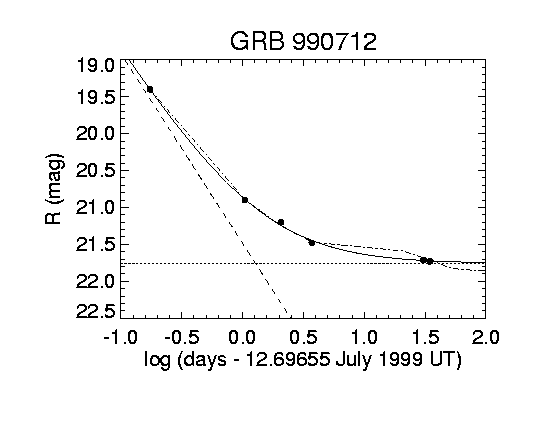
The updated R-band light curve of the optical afterglow of GRB 990712.
The three first points are from SAAO, the fourth point is based on our
NTT image. The fifth point is based on our VLT image. The last point
is Kemp & Halpern's CTIO data point. Error bars are about the size of
the data points. In the simplest model, the dotted line shows the contribution
from the host galaxy (R = 21.76) and the dashed curve is the assumed power
law decline (index = -1.03) of the optical afterglow emission. The solid
curve is the combined effect of these contributions and gives a good
fit to the observations. The dashed-dotted curve shows the light curve of
the host galaxy (R = 21.92) + power law (index = -1.00) + SN model.
This model also gives a good fit to the observations.
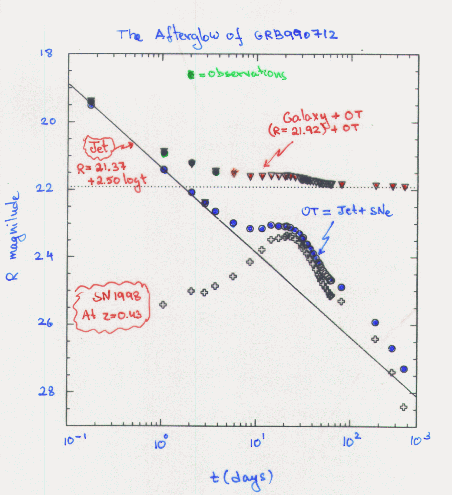
More details about the predictions of the SN model
- GCN notice #565
A. Fruchter, K. Sahu, R. Gibbons, L. Petro and H. Ferguson (STScI) on
behalf of the larger HST GRB collaboration report:
We have observed the field of GRB 990712 with the HST STIS CCD on
August 29, 1999, 48 days after outburst. Observations with total
exposures times of 3720s were taken in both the (50CCD) clear aperture
and (LP) long pass filters. At the position of the previously located
OT (GCN reports starting with GCN 387), we find a disk galaxy with two
apparent knots along its major axis. Using the astrometry of Sahu et
al. (2000, Ap J. accepted) we are able to place the position of the OT
on our image to a one-sigma accuracy no better than 0."15, where the
source of the error is nearly equally divided between that of the plate
solution in Sahu et al.'s original image and the measurement of the
relative position of the OT to the astrometric calibrators in that
image. The best estimate position of the OT is offset from the fainter
blue knot by only 0."07; however, a brighter red knot lying 0."24 from
the best estimate position can not be ruled out as the true location of
the OT.
The images are displayed at
http://www.stsci.edu/~fruchter/GRB/990712 and reproduced below:
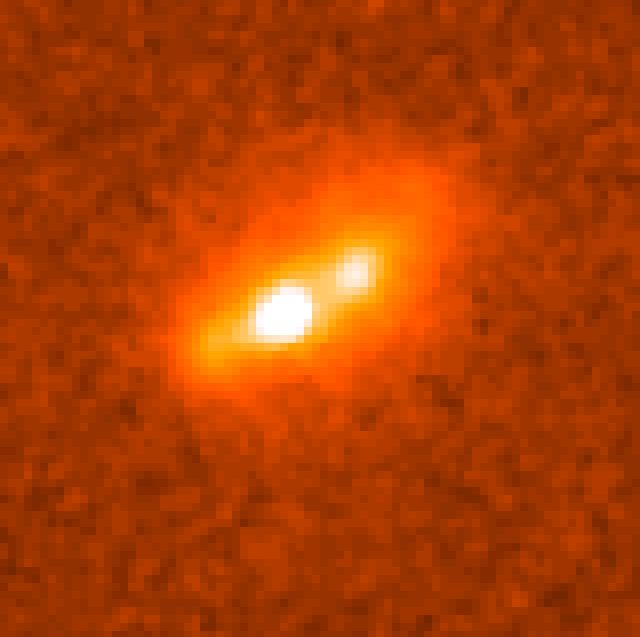
These results are being published now because comments from members of
the community have made it clear that there is great interest even in
inconclusive HST results. However, this object is scheduled to be
reobserved in late April or early May of this year. The resulting
images, when subtracted from those reported here, should allow an
unambiguous identification of the OT, and an accurate determination of
its magnitude and color at this first HST epoch.
- More info from http://www.stsci.edu/~fruchter/GRB/990712:
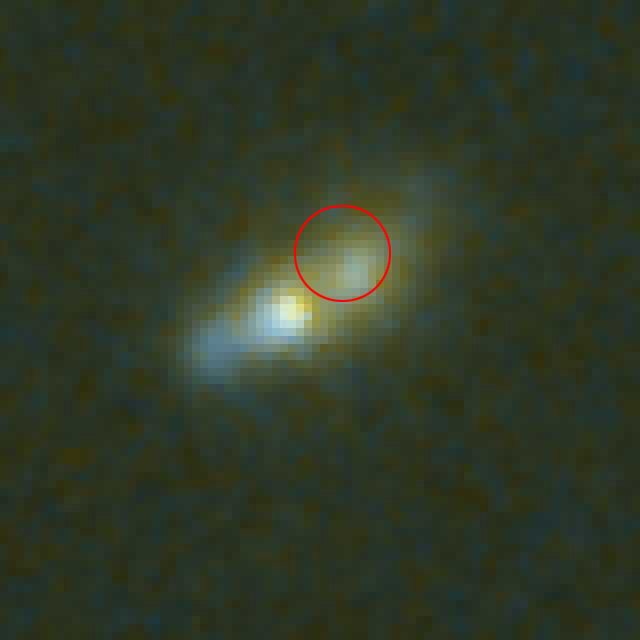
A color image of the host of GRB 990712, made by scaling
B to 50CCD-LP, G to 50CCD+LP, and R to LP. The one sigma error
circle for the position of the optical transient, based on the
astrometry of Sahu et al. (2000) is shown in red
Because the OT is located on a relatively bright (V~23) galaxy, its
magnitude cannot be accurately determined without knowing the
underlying surface brightness of the galaxy. However, an upper limit
to the brightness of the OT can be estimated by point source
subtraction from the knots. If the OT is contained under the fainter
blue source then the maximum allowable point source subtraction
has a magnitude R = 25.6 +/- 0.2 with estimated spectral index of
f(nu)=nu^{-1 +/- 0.5}, where the error in the power-law index is
dominated by systematic errors due to the present uncertainty in the
calibration of the STIS LP filter. This magnitude and color is
consistent with an extrapolation of the power-law decay of the OT
reported by Sahu et al., and would effectively rule out a SN component
to this afterglow. However, if the OT is in fact associated with the
brighter, redder object, then the maximum allowable point source has
R = 24.5 +/- 0.25 with f(nu)=nu^{-3 +/- 0.5}. A SN with absolute
magnitude about 1 mag fainter than 1998bw could be then accommodated.
- GCN notice #752
A. Fruchter (STScI), P. Vreeswijk (UvA), R. Hook (ST-ECF) and E. Pian
(OA Trieste) report for a larger HST GRB collaboration:
We have observed the field of GRB 990712 with the HST STIS CCD on April
24, 2000, 287 days after outburst. Observations with total exposure
times of 3720 s were taken in both the (50CCD) clear aperture and (LP)
long pass filter. We have compared these images with those taken of
this GRB and its host galaxy with the same instrumentation 48 days
after outburst (Fruchter et al. 2000).
We find that the optical transient (OT) associated with the GRB is
located on the bright red knot towards the southeastern end of this
elongated galaxy. Thus the OT is not associated with the faint blue
knot toward the northwest end of the galaxy as was claimed in the
literature on the basis of the first HST observation alone (Hjorth et
al. 2000).
After subtracting the images from the two epochs we find an OT
magnitude on August 29, 1999 of R=24.35 +/- 0.15, where the error is
dominated by the uncertainty due to the wide STIS filters. If the OT
were to have fallen between the two epochs as a simple power-law of
t^{-1} (Sahu et al. 2000) this would have oversubtracted the OT by
about 0.15 mags. However, if a supernova provided a significant
contribution at the first epoch, there would be little
oversubtraction.
The color of the OT at day 48 is quite red, with a ratio of counts
between LP and 50CCD of 0.73 +/- 0.1. If the OT were indeed dominated by a
supernova of color similar to that of SN1998bw, we would have expected
a ratio about 1 sigma bluer, and an OT of the colors reported by Sahu
et al. (2000) would be about 1 sigma bluer still. In any event, as
noted in our previous GCN, a supernova would have to be at least one
magnitude fainter than SN1998bw to agree with these observations.
The host galaxy is approximately 1.5" in length, and has an ellipticity
of ~0.5. The R magnitude of the host is found to be 21.95 +/- 0.15 in
good agreement with Sahu et al. (2000). The color of the galaxy is
seen to vary across the stellar disk, with perhaps some evidence for a
dust lane near the galaxy's center.
The images are displayed at:
http://www.stsci.edu/~fruchter/GRB/990712.
Fruchter, A., et al. 2000, GCN 565
Hjorth, J., et al. 2000, ApJ, 534, L147
Sahu, K., et al. 2000, ApJ, in press (astro-ph/0003378)
On the left in the above image
is the August 1999 STIS 50ccd image of GRB 990712, on the right
April 2000 50ccd image. The field
of view in each case is 1."6. The images have been
drizzled onto an output grid with pixels one-half the size of the original
STIS pixels, or about 0."025 on a side. The bright knot on to the south-east
can be seen to have varied.
On the left is the STIS LP image of GRB 990712 from August 1999,
and on the right is the subtraction of the April 2000 LP image from the
August 1999 image. Only the optical transient remains.
- astro-ph/0607195 from 10 Jul 2006
Küpcü Yoldas: Constraining the environment of GRB 990712 through emission line fluxes
The energy output in the gamma-ray burst (GRB) prompt emission and afterglow
phase is expected to photoionize the surrounding medium out to large radii.
Cooling of this gas produces line emission, particularly strong in the optical,
whose variability is a strong diagnostics of the gas density and geometry in
the close environment of the burst. We present the results of a spectral time
series analysis of the host galaxy of GRB 990712 observed up to ~6 years after
the burst. We analyze the emission line fluxes together with those of the
previous observations of the same GRB, in search for photoionization
signatures. We find that the emission line fluxes show no variation within the
uncertainities up to 6 years after the burst, and we use the measured line
intensities to set a limit on the density of the gas within a few parsecs of
the burst location. This is the first time that emission from cooling GRB
remnants is probed on years time scales.
![]() Previous IAU Circulars
Previous IAU Circulars 






